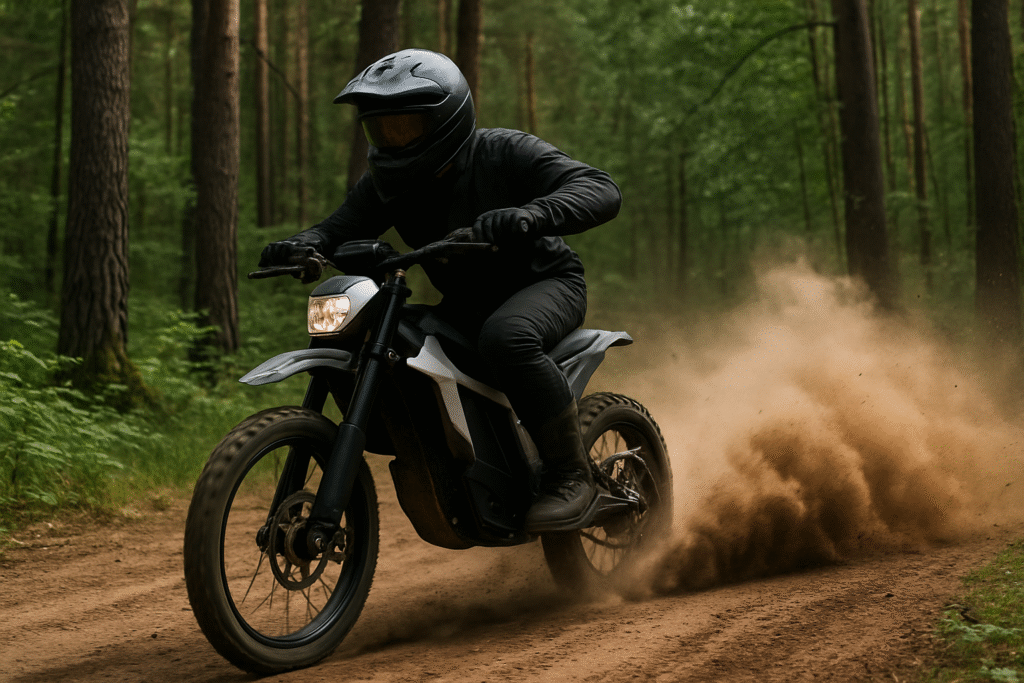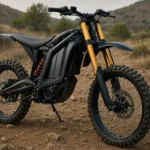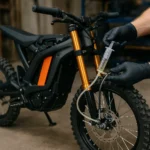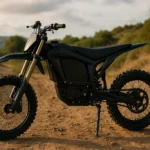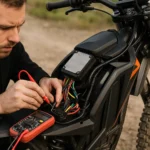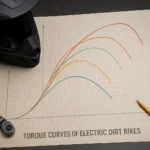Electric dirt bike helmet laws are a critical part of riding responsibly, whether you’re blasting through dirt trails or cruising your neighborhood. These regulations aren’t just formalities—they exist to protect riders from serious head injuries, especially in high-risk environments. 🧠
Understanding electric dirt bike helmet laws can help you avoid fines, injuries, and even legal issues. Whether you’re a parent of a young rider or a weekend off-roader, being informed is non-negotiable.
Helmet rules vary significantly across states. Some require all riders to wear DOT-approved helmets, while others only mandate them for those under 18. Off-road electric dirt bikes also fall under different safety categories compared to street-legal models, adding another layer of complexity. If you’re unsure whether your bike is allowed on the streets, check out our guide on whether electric dirt bikes are street legal to get the full picture. 🛣️
Many riders ask, “Can I just wear a bicycle helmet?” The answer, in most cases, is absolutely not. Helmet requirements often specify motorcycle-grade protection like DOT, ECE, or Snell certification. If your helmet isn’t certified, it likely won’t pass inspection—and won’t save your head in a crash.
What’s even more important? If your child is riding and not wearing a helmet, you might be legally responsible. Electric dirt bike helmet laws often include parental liability clauses, especially for minors under 16. Knowing the rules can literally protect your family—and your wallet. 💸
Ignoring electric dirt bike helmet laws might seem like no big deal, but the penalties can be harsh. From on-the-spot fines to losing riding privileges on public land, the consequences can snowball quickly. And in some cases, insurance won’t cover accidents if the rider wasn’t wearing proper headgear.
So if you’re wondering which type of helmet to buy, what the age limits are, or whether your state even enforces these rules—you’re in the right place. This guide breaks it all down in plain English, with real examples and updated data. 🤓
Stay safe, stay smart, and ride legal. Because electric dirt bike helmet laws aren’t just about avoiding tickets—they’re about staying alive and protecting the ones you love. ❤️
Key Takeaways
- Helmet laws vary by state, country, and age group
- Not all helmets are legal for dirt bike use—DOT and other certifications matter
- Penalties for non-compliance can include fines, confiscation, and legal trouble
- Some places have different rules for off-road vs. on-road electric dirt bikes
- Parents are often legally responsible for minors not wearing helmets
⚡ Here’s What You’ll Discover in This Guide: Use the quick links below to explore what matters most to you 👇
What Are Electric Dirt Bike Helmet Laws?
Electric dirt bike helmet laws define the legal requirements for helmet use when operating an electric dirt bike. These laws are set by each state or country and are often influenced by factors like rider age, terrain, and public road access. While some regions enforce strict universal rules, others apply different standards depending on whether the bike is used on private land or public trails.
At their core, electric dirt bike helmet laws are designed to reduce the risk of head injuries. Helmets play a critical role in minimizing the impact during falls or collisions, which are common in both casual and competitive dirt biking. Because electric dirt bikes are often used by young riders, lawmakers have placed extra emphasis on safety compliance.
In most areas, these laws specify not just when a helmet is required, but also what type is acceptable. A helmet that meets motorcycle safety standards—like DOT or Snell—is usually mandated. Wearing a bicycle helmet, novelty helmet, or uncertified headgear may not meet the legal threshold.
Another key element of electric dirt bike helmet laws is the rider’s age. Minors are typically held to stricter standards, and in many cases, parents or guardians can be held liable if a child is caught riding without a helmet. Some states even require helmet use for passengers, regardless of age.
Finally, these laws often include penalties for non-compliance. Riders caught without approved helmets may face fines, community service, or even confiscation of their bikes. For repeat offenses, the consequences can be more severe, especially if accidents are involved.
Electric dirt bike helmet laws may not be the most exciting part of riding—but they’re one of the most important. Knowing the basics can save your ride, your license, and your brain 🧠.
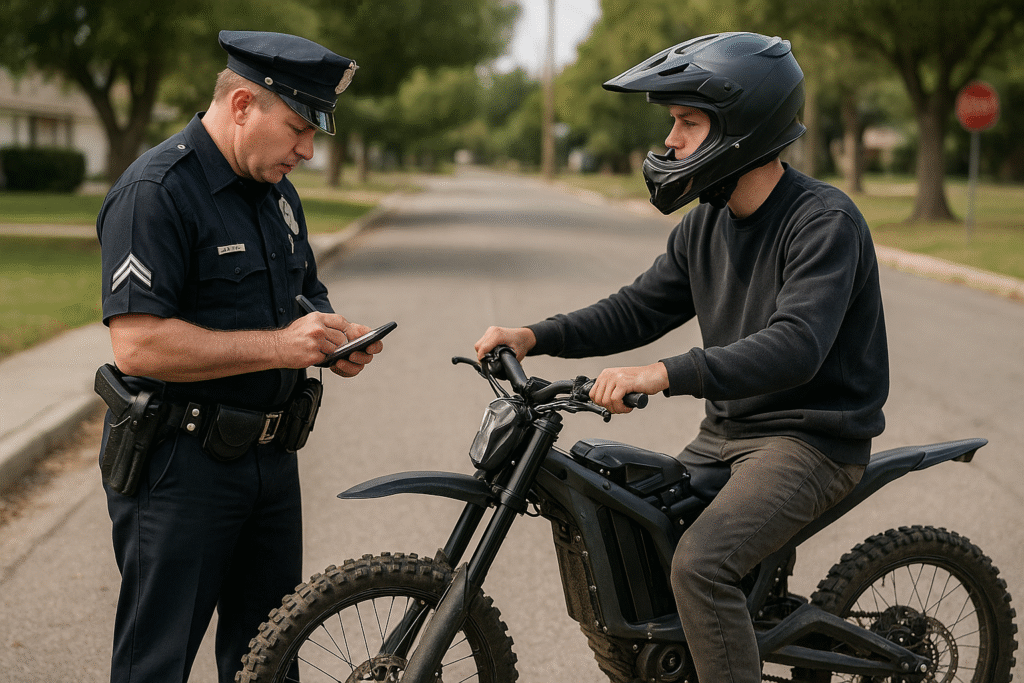
Why Helmet Laws Exist (And Why You Should Care)
Electric dirt bike helmet laws aren’t just government red tape—they exist for a reason. Every year, thousands of riders end up in emergency rooms with head injuries that could have been prevented with a proper helmet. The rise of high-speed electric dirt bikes has only made this issue more urgent.
Most accidents happen during recreational riding, often involving younger, less experienced riders. A helmet can literally be the difference between walking away with a scrape or being airlifted to the hospital. ⚠️
But it’s not only about personal safety. These laws also exist to reduce the financial burden on public health systems, protect against long-term disability, and encourage responsible riding behavior from an early age. When riders—especially minors—fail to wear helmets, it reflects a broader culture of risk that can affect entire communities.
There’s also a growing concern about moped-style electric dirt bikes being used on roads without proper gear. These bikes can hit speeds that rival gas-powered models, which means helmet laws are more relevant than ever. If you’re curious how safety laws intersect with street legality, check out this helpful breakdown from HOVSCO’s guide on how safe and legal electric dirt bikes really are.
Wearing a helmet isn’t just about avoiding a fine—it’s about riding with confidence, knowing that you’re covered in case something goes wrong. Because when it comes to electric dirt bikes, speed and silence can be a dangerous combo without the right protection. 🧠
Types of Helmets That Are Legally Approved
Not all helmets are created equal—especially when it comes to meeting the standards set by electric dirt bike helmet laws. Many riders make the mistake of grabbing any helmet off the shelf, assuming it’s good enough. But when the law steps in, only certain types actually qualify.
The most commonly accepted certification in the United States is the DOT (Department of Transportation) standard. This ensures the helmet meets minimum impact protection, retention, and penetration resistance guidelines. Other widely recognized certifications include ECE 22.05 or 22.06 (used in Europe) and Snell, which is often considered one of the most rigorous safety standards available.
Helmets with these certifications are designed to handle the high-impact crashes typical in dirt bike riding. They usually feature thick inner liners, durable outer shells, and secure retention systems. Some helmets even include multi-directional impact protection systems (MIPS), adding an extra layer of safety against rotational forces.
On the other hand, helmets not approved for electric dirt bike use—like bicycle helmets, novelty helmets, or uncertified imports—won’t pass legal inspection. Worse, they offer minimal real protection. Riders caught using these may face fines or be held liable in accidents.
It’s also worth noting that helmet laws often specify the condition of the helmet. Cracked, aged, or modified helmets can be considered non-compliant, even if they were legal at the time of purchase. That means it’s essential to check not only the certification but also the current condition of your gear.
Choosing a helmet that meets the legal standards isn’t just about compliance—it’s about safety, peace of mind, and being able to ride without second-guessing your protection.
Helmet Laws by Age Group
Electric dirt bike helmet laws often change depending on the rider’s age. Lawmakers tend to be much stricter with minors, and for good reason—young riders are more likely to take risks, have less experience, and suffer more serious injuries in crashes. Age-specific helmet regulations help ensure the right level of protection is in place for every stage of a rider’s development.
Under 12 Years Old
In nearly every state, riders under 12 are required to wear a helmet at all times when operating an electric dirt bike. The helmet must be certified—usually DOT-approved—and fit properly. Some states even require chin straps to be secured at all times or mandate full-face helmets for younger riders.
Parents are often held accountable if a child is caught riding without a helmet, which can result in fines or warnings. In some jurisdictions, repeated violations can escalate to more serious consequences, including legal citations for negligence.
Ages 13–17
For teenagers, helmet laws remain strict in most areas. Riders in this age group are statistically involved in more high-speed crashes, especially on trails or open fields. Because of this, laws often mirror those for younger kids, with very little leniency.
Teens may also face consequences directly, such as fines or warnings. In states where electric dirt bikes can be registered for limited street use, wearing an approved helmet is mandatory to avoid losing riding privileges.
18 and Older
Once riders reach adulthood, helmet laws become more flexible—but not nonexistent. Some states allow adults to ride without a helmet, but this usually comes with conditions, such as carrying extra insurance or proving completion of a safety course.
Even in states where helmets are optional, choosing to ride without one carries risks. Aside from the obvious safety concerns, many insurance providers reduce or deny coverage in the event of a crash if the rider wasn’t wearing proper gear.
Age matters when it comes to electric dirt bike helmet laws, and knowing the rules for your group ensures that you’re protected both physically and legally every time you ride.
Helmet Laws by State (With Table)
One of the most confusing parts of electric dirt bike helmet laws is how they vary from state to state. While federal guidelines exist for on-road motorcycles, electric dirt bikes often fall into a gray area—especially when used off-road or on private property. This makes it essential to know your local regulations before you ride.
Some states require all riders, regardless of age, to wear DOT-approved helmets. Others only apply these rules to minors. A few states offer more relaxed regulations, but even then, consequences for non-compliance can still be serious—particularly if an accident occurs.
To help make sense of it all, here’s a simplified overview of how helmet laws look across several U.S. states:
| State | Helmet Required (All Ages?) | Type of Helmet Required | Penalty for Violation |
|---|---|---|---|
| California | Yes | DOT-approved | $197 fine |
| Texas | Under 21 | DOT or Snell | $25–$100 fine |
| Florida | Under 16 | DOT or ECE | Parental citation |
| New York | Yes | DOT-certified | $50–$100 fine |
| Arizona | Under 18 | DOT-certified | Up to $75 fine |
| Pennsylvania | Under 21 (with conditions) | DOT-approved | Warning or citation |
| Colorado | Under 18 | DOT or ECE | Up to $85 fine |
| Washington | Yes | DOT or Snell | $124 fine |
| Georgia | Yes | DOT-certified | $25–$200 fine |
| Nevada | Yes | DOT or ECE | Up to $100 fine |
This table provides a starting point, but laws can change quickly, and enforcement may vary depending on the riding environment—public roads, trails, or private land. Always double-check with local authorities to stay current and compliant.
Knowing your state’s stance on helmet laws ensures you’re not only riding legally but also protecting yourself and those around you.
What Happens If You Ignore Helmet Laws?
Ignoring electric dirt bike helmet laws can come with more consequences than most riders expect. It’s not just about getting a ticket—it can impact your legal standing, insurance coverage, and even your ability to ride in certain areas.
The most common penalty is a monetary fine. Depending on your location and age, this can range from $25 to over $200. For minors, the fine may be issued to a parent or guardian, which can lead to legal tension and added responsibility.
In some states, riding without a helmet can result in your electric dirt bike being impounded on the spot. This is especially true in areas where law enforcement takes a stricter approach to off-road vehicle safety. In other cases, you might be issued a warning the first time—but don’t expect that courtesy more than once.
Insurance can also become a problem. If you’re involved in an accident while not wearing a helmet, your provider may reduce your payout—or deny it entirely. Some policies clearly state that safety gear must be worn for coverage to apply. For serious crashes, this could mean thousands of dollars in out-of-pocket expenses.
And then there’s liability. If you’re riding on someone else’s property, or with others, and you’re not wearing a helmet, you might be held liable for injuries, even if you’re not at fault. Courts tend to take helmet laws seriously, especially when minors are involved.
Bottom line? Skipping the helmet may seem harmless in the moment, but the long-term risks—from fines to injuries—just aren’t worth it. Following electric dirt bike helmet laws is the smarter, safer move every single time.
Are Helmet Laws Different for Off-Road Use?
Electric dirt bike helmet laws don’t always apply the same way when you leave the pavement. In fact, many states and municipalities treat off-road riding as a separate category, with its own set of rules and enforcement practices. That’s why it’s crucial to understand how helmet regulations shift when you’re riding in dirt, sand, or on trails.
In general, helmet laws for off-road riding are still enforced—especially on public lands like state parks, national forests, or designated OHV (off-highway vehicle) trails. These areas often require all riders, regardless of age, to wear certified helmets that meet specific safety standards. Local rangers and law enforcement officers can and do issue fines to those who don’t comply.
However, things change a bit on private property. If you’re riding on land that you or someone you know owns, some states allow more flexibility. In these cases, helmet use may be strongly recommended but not legally required. That said, if an accident occurs, liability can become a serious issue—especially if a minor is involved and wasn’t wearing a helmet.
Off-road events, races, and motocross tracks often have their own mandatory helmet policies, regardless of state law. Organizers typically require DOT or Snell-approved helmets for entry, and they enforce these rules to ensure rider safety and avoid legal complications.
It’s also important to note that while off-road use may seem more relaxed, the risks are still high. Uneven terrain, unexpected obstacles, and higher speeds can lead to crashes just as dangerous—if not more so—than those on pavement. Helmets are just as critical off the road as they are on it.
So even if the law doesn’t require a helmet in your specific off-road setting, choosing to wear one is a no-brainer. Safety should always ride shotgun, whether you’re tearing through trails or navigating your backyard track.
Can You Be Pulled Over for Not Wearing a Helmet?
Yes—you absolutely can be pulled over for not wearing a helmet while riding an electric dirt bike, depending on where you’re riding and the local laws in place. Many riders assume helmet checks only happen on major roads, but that’s not the case. Enforcement happens everywhere, especially in areas where electric dirt bikes are popular among youth or where off-road paths cross public land.
Law enforcement officers are trained to identify safety violations, and helmet use is one of the easiest to spot. If you’re riding without a certified helmet in a state where it’s required, expect to be stopped. In some areas, especially during weekends or holidays, local police increase patrols on trails and in neighborhoods where electric dirt bikes are common.
The penalties for getting pulled over can vary. First-time offenders might get a warning, but in many states, you’ll be issued a citation on the spot. Repeat offenses often lead to higher fines, mandatory safety courses, or even the temporary seizure of your dirt bike.
It’s not just police on the lookout either. Park rangers, community patrol officers, and even school resource officers near public campuses can take action if they see minors riding without proper headgear.
Another factor that increases your chances of getting pulled over is riding in areas where electric dirt bikes are already under scrutiny. Some neighborhoods have strict local ordinances due to noise complaints or reckless behavior, which means any safety infraction—like not wearing a helmet—becomes an easy reason for enforcement.
Wearing a helmet isn’t just about safety—it’s a legal shield. It gives officers no reason to stop you, keeps you compliant with the law, and shows the community that you ride with responsibility. That kind of reputation matters, especially if you’re young or riding in shared spaces.
What Helmet Should You Actually Buy?
Choosing the right helmet isn’t just about comfort or style—it’s about meeting the legal standards and keeping your head safe when things go sideways. With electric dirt bike helmet laws getting stricter, picking a helmet that checks all the right boxes has never been more important.
Start by looking for certification labels. In the U.S., the DOT (Department of Transportation) approval is the baseline for legality. Some helmets also include ECE or Snell certifications, which are even more rigorous. These labels should be visible on the back or inside the helmet. If you don’t see one, don’t buy it.
Full-face helmets offer the most protection and are widely recommended for electric dirt bike riders. They shield not just the skull but also the face and jaw—areas commonly impacted in dirt bike crashes. If you’re riding off-road or at higher speeds, this style is often the safest and most law-compliant option.
Ventilation is another feature to consider. Many riders overlook airflow, but if you’re out in the heat or going full throttle on a trail, you’ll appreciate a helmet that keeps your head cool without sacrificing protection.
Fit is critical. A helmet that’s too loose won’t protect you properly in a crash, and one that’s too tight will cause discomfort and distractions. Most manufacturers provide sizing charts—take measurements and try different models if needed. A properly fitted helmet should feel snug but not painful.
Don’t forget about visibility. Helmets with wide face openings or integrated visors help maintain a clear field of vision, which is vital when navigating unpredictable terrain.
Lastly, avoid used or heavily discounted helmets from questionable sources. If a helmet has been dropped, cracked, or exposed to UV damage, its integrity may be compromised—even if it looks fine on the outside.
Investing in a high-quality, certified helmet is one of the smartest decisions you can make as a rider. It keeps you legal, protects your brain, and shows you take your safety seriously.
Real-Life Cases and Stats That Might Shock You
When it comes to electric dirt bike helmet laws, the numbers don’t lie—and the stories are even more convincing. Each year, emergency rooms report thousands of dirt bike-related injuries, many involving head trauma that could have been prevented with proper helmet use. What’s even more alarming is how many of these cases involve young, first-time riders.
One report from a regional trauma center found that nearly 70% of electric dirt bike accident victims under 18 weren’t wearing helmets at the time of injury. Many of these incidents occurred during casual neighborhood rides or on short off-road trails—places where riders tend to let their guard down.
Take, for example, the case of a 14-year-old who suffered a fractured skull while riding his electric dirt bike on a dirt trail behind his school. He wasn’t wearing a helmet. The medical bills exceeded $45,000, and his parents faced additional legal pressure for allowing him to ride without proper safety gear. It’s a harsh reminder that a split-second decision can carry long-term consequences.
On the flip side, there are countless stories of riders walking away from brutal crashes because they wore the right helmet. Helmets aren’t just suggested gear—they’re the difference between a close call and a life-changing injury.
If this kind of data feels overwhelming, you’re not alone. That’s why we created a complete breakdown to help riders understand where they’re allowed to ride legally and what gear they need to stay compliant. If you’re still unsure about where electric dirt bikes can or can’t go, check out our full guide on electric dirt bike street legality.
The takeaway is simple: the law exists because these injuries are real, and they happen fast. Protecting your head protects your future—no matter how experienced you think you are.
FAQs About Electric Dirt Bike Helmet Laws
Do all states in the US require helmets for electric dirt bikes?
No, helmet requirements vary by state. Some states mandate helmet use for all riders, while others only require it for minors or in specific public areas. It’s important to check your local laws before riding.
Is a bicycle helmet enough for riding an electric dirt bike?
In most cases, no. Bicycle helmets typically don’t meet the legal safety standards required for electric dirt bike riding. Look for DOT, ECE, or Snell-certified helmets for full compliance and protection.
Can I get fined for not wearing a helmet even if I’m riding off-road?
Yes, especially if you’re on public trails or state-managed land. Even off-road riding can be subject to enforcement depending on the location and local regulations.
Are parents legally responsible if their child rides without a helmet?
Yes. In many states, parents or guardians can be fined or cited if a minor is caught riding an electric dirt bike without a helmet. Repeat offenses may carry harsher consequences.
Do I need a different helmet for off-road vs. street riding?
Not necessarily. Many DOT-approved helmets are suitable for both environments. However, full-face helmets designed for off-road riding may offer added protection and ventilation for trail use.
What’s the penalty for not following electric dirt bike helmet laws?
Penalties can include fines, community service, or even having the bike impounded. In some cases, especially involving minors, there may be legal consequences for the parent or guardian.
Can I wear a used helmet as long as it’s certified?
It’s not recommended. Even certified helmets lose effectiveness over time or after impact. A used helmet might have hidden damage that compromises its ability to protect you.
Are there exceptions to helmet laws based on age or experience?
Some states allow adults to ride without a helmet under certain conditions, like having extra insurance or completing a safety course. However, these exceptions are rare and should be verified locally.
Final Thoughts: Don’t Gamble With Your Brain
Electric dirt bike helmet laws aren’t there to ruin the fun—they’re in place to make sure you get to ride another day. Whether you’re a beginner learning the ropes or a seasoned rider who thinks they’ve seen it all, skipping a helmet is never worth the risk.
It’s easy to get caught up in the excitement of hitting the trail or cruising around the block. But one small mistake—one unexpected bump, slip, or miscalculation—can lead to a crash that changes everything. A helmet doesn’t just protect your head; it protects your future, your freedom, and your ability to keep doing what you love.
Parents, this one’s especially for you. Don’t assume that “just this once” without a helmet is harmless. Electric dirt bikes are fast, and kids are fearless. It’s your job to set the example and enforce the rules. Laws aside, it’s about keeping your child out of harm’s way.
If you take your riding seriously, you should take your safety seriously too. A certified helmet is the simplest investment you can make for maximum protection with minimum effort. Wear it. Adjust it properly. Replace it when needed.
At the end of the day, electric dirt bike helmet laws are just one part of being a responsible rider. Respect the law, respect the gear, and respect the ride.
Join the Conversation and Ride Smarter
If this guide opened your eyes to how important electric dirt bike helmet laws really are, don’t keep it to yourself. Share what you’ve learned with fellow riders, parents, or anyone in your circle who’s hopping on an electric dirt bike for the first time.
Your experience matters. Got a favorite helmet brand that saved your skin? A cautionary story others should hear? Drop it in the comments and let’s keep this community informed and protected.
We believe smart riding starts with the right information—and you’ve just taken a big step toward that. If you’re ready to go even deeper into legal riding and safety, don’t miss our complete resource on electric dirt bike street legality. It ties directly into everything we’ve covered here and helps you ride confidently, wherever the trail leads.
Thanks for being part of the Electric Dirt Zone family—now go ride safe, ride smart, and always wear that helmet.

Tyler Brooks is the storyteller behind most of the content at Electric Dirt Zone. With over 10 years of experience in digital media and a lifelong love for off-road riding, he blends technical insight from the team with engaging, down-to-earth writing. When he’s not turning dusty trail rides into blog posts, you’ll probably find him snapping pics before things get too wild.

